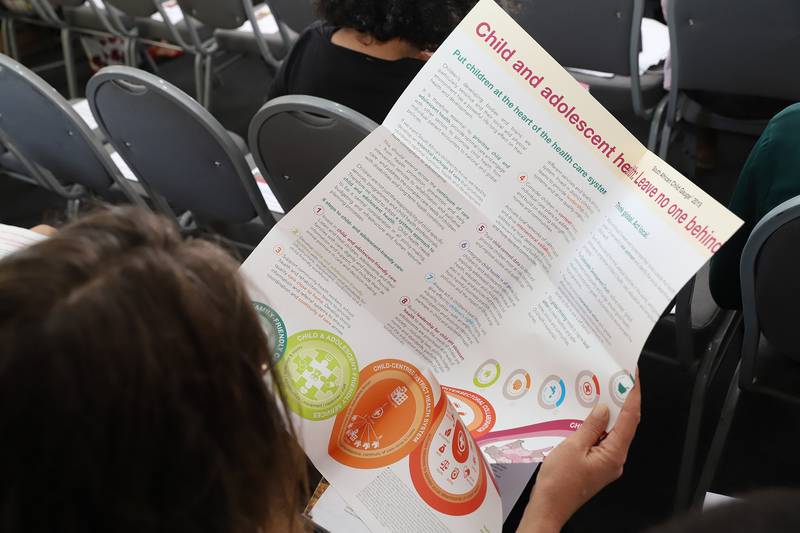Child Gauge: Prioritising child and adolescent health
12 December 2019 | Story Supplied. Photo Michael Hammond. Read time 7 min.
One in every 31 children in South Africa will die before their fifth birthday. This is a sobering reality as International Human Rights Day was marked on Tuesday, 10 December, and on the 30th anniversary of the United Nations Convention on the Rights of the Child, which sets out the rights that must be realised for children to develop to their full potential.
Greater investment in child and adolescent health is needed to ensure that the other 30 children are able to thrive and reach their full potential. Over the past 10 years, South Africa has made huge strides in reducing under-five mortality and deaths due to HIV from a high of 79 deaths per 1 000 live births in 2004 to 32 deaths per 1 000 in 2017.
Yet most children are still dying from preventable causes such as neonatal conditions, HIV, diarrhoea, pneumonia and injuries. South Africa needs to pay greater attention to the health and development of those children who survive and address the burden of malnutrition, HIV, violence and mental health problems.
The South African Child Gauge 2019, which was released on 10 December, explores how early investment in childrenʼs health offers the greatest returns on child and adolescent development and has the potential to yield a triple dividend by improving the health of children today, the adults they will become tomorrow, and the health and development of the next generation of children.
This 14th annual review of the situation of the country’s children is published by the Children’s Institute (CI) at the University of Cape Town (UCT). The theme of the 2019 report – “Child and Adolescent Health: Leave no one behind” – is a call to prioritise child and adolescent health and put children at the heart of the healthcare system.
Intervening early
In the foreword to the report, First Lady Dr Tshepho Motsepe said, “The science is clear. If we want to promote cognitive development, break the intergenerational cycles of poverty and violence, and halt the growing epidemic of obesity and non-communicable diseases, we need to invest early – starting in the first 1 000 days of a child’s life and continuing into adolescence. Investments during these two sensitive periods of development yield the greatest returns.”
Adopting a life-course approach and intervening early to protect children from adversity interrupts the intergenerational cycles of poverty, violence and ill health.
Intervening outside the clinic
Lori Lake, communications and education specialist at the Children’s Institute and one of the lead editors of the 2019 edition of the South African Child Gauge, explained: “Over the past decade, we have made gains in reducing child poverty and improving children’s access to services, so there is a strong foundation on which to build. Yet nearly 60% of children still live below the poverty line, 30% do not have access to piped water on site, and nearly 20% live in overcrowded households.”
These kinds of living conditions make it extremely difficult for families to meet children’s basic needs and protect them from harm.
It is therefore not surprising that 27% of young children are stunted, 42% have experienced some form of physical, sexual or emotional abuse, an estimated 10–20% of children have a diagnosable mental health condition such as depression, anxiety or a substance use disorder, and 37% of youth are not in employment, education and/or training.
This is compounded by poor access to healthcare services with 20% of children having to travel long distances to reach a healthcare facility.
“Over the past decade, we have made gains in reducing child poverty and improving children’s access to services.”
“We have to recognise that health professionals have a responsibility for child health that extends beyond the walls of their clinic or hospital,” said Motsepe.
“We need to get to know where children come from and who they live with. We should understand the challenges they face and put care plans in place that build on existing strengths in order to promote and safeguard children’s health when they return to their homes, schools and communities.”
There is therefore an urgent need to look beyond individual behaviour and to address some of the social and structural determinants of child health.
Intervening in policy
South African Minister of Health Dr Zweli Mhkize has committed to prioritising three areas to improve child health: achieving universal health coverage by implementing National Health Insurance (NHI), better community engagement and mobilisation through community health workers, and identifying critical periods of intervention, namely the first 1 000 days and adolescence.
“Having not met our [United Nations] Millennium Development Goal targets for reducing maternal and child mortality, it is particularly important that we carefully monitor progress with regards to meeting the Sustainable Development Goal targets – we dare not take our eyes off the ball. This edition of the Child Gauge can play an important role in monitoring progress, identifying gaps and suggesting remedial actions,” he said.
According to Professor Anthony Westwood and Doctor Wiedaad Slemming from UCT and the University of the Witwatersrand respectively, the NHI initiative provides an opportunity to improve long-term care for children but only if the proposed “basket of care” includes children with long-term health conditions (LTHCs) and rehabilitation services are strengthened at the district level to support the large numbers of children with LTHCs and disabilities – especially those in rural areas where services are thinly stretched.
A new vision for child and adolescent health
“A child-centred healthcare system requires a clear vision that extends beyond the treatment of illness and injury to one that promotes optimal health, nutrition and development; addresses the complex care needs of children with long-term health conditions; engages with children and families with the utmost care and respect; and includes them as active partners in healthcare and decision-making,” said Maylene Shung King, associate professor at UCT.
Such a vision should inform the development of an essential package of healthcare services, and norms and standards for medicines, equipment and infrastructure, in order to ensure that child and adolescent health receives a fair share of resources. It also requires the reorientation and training of health and allied professionals in order to build a workforce for child and adolescent health.
Over the past 10 years South Africa has made good progress, yet much work remains to be done. Strong leadership and champions of children will be needed at all levels of the healthcare system in order to close the gap and ensure that all South Africa’s children are able to thrive.
Child health is everyone’s business.
The South African Child Gauge is produced in partnership with UNICEF South Africa; the Department of Science and Innovation and National Research Foundation (DSI-NRF) Centre for Excellence in Human Development at the University of the Witwatersrand; The Standard Bank Tutuwa Community Foundation; and the Desmond and Leah Tutu Legacy Foundation.
 This work is licensed under a Creative Commons Attribution-NoDerivatives 4.0 International License.
This work is licensed under a Creative Commons Attribution-NoDerivatives 4.0 International License.
Please view the republishing articles page for more information.
Research & innovation





































